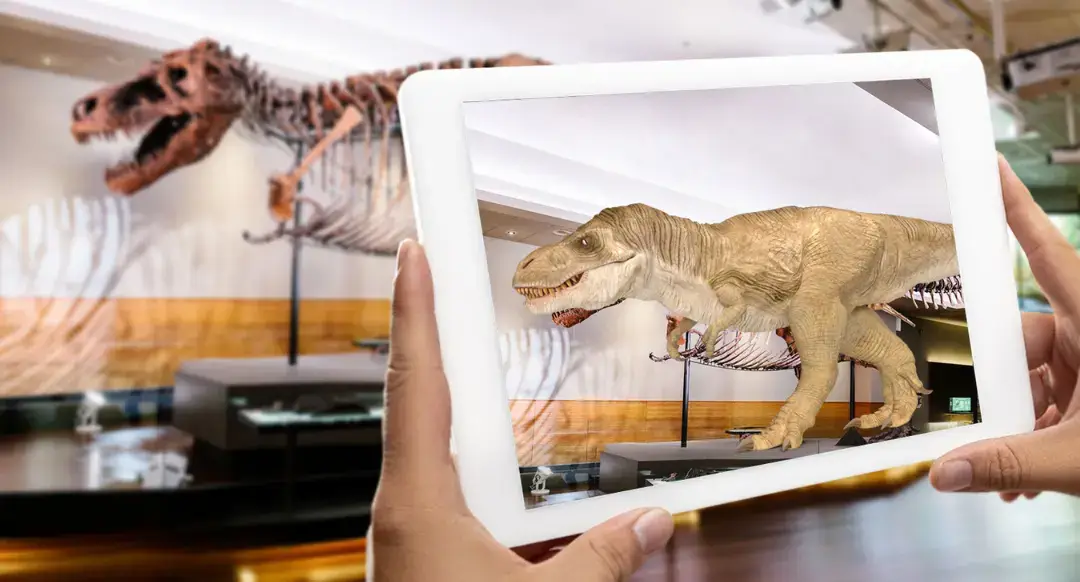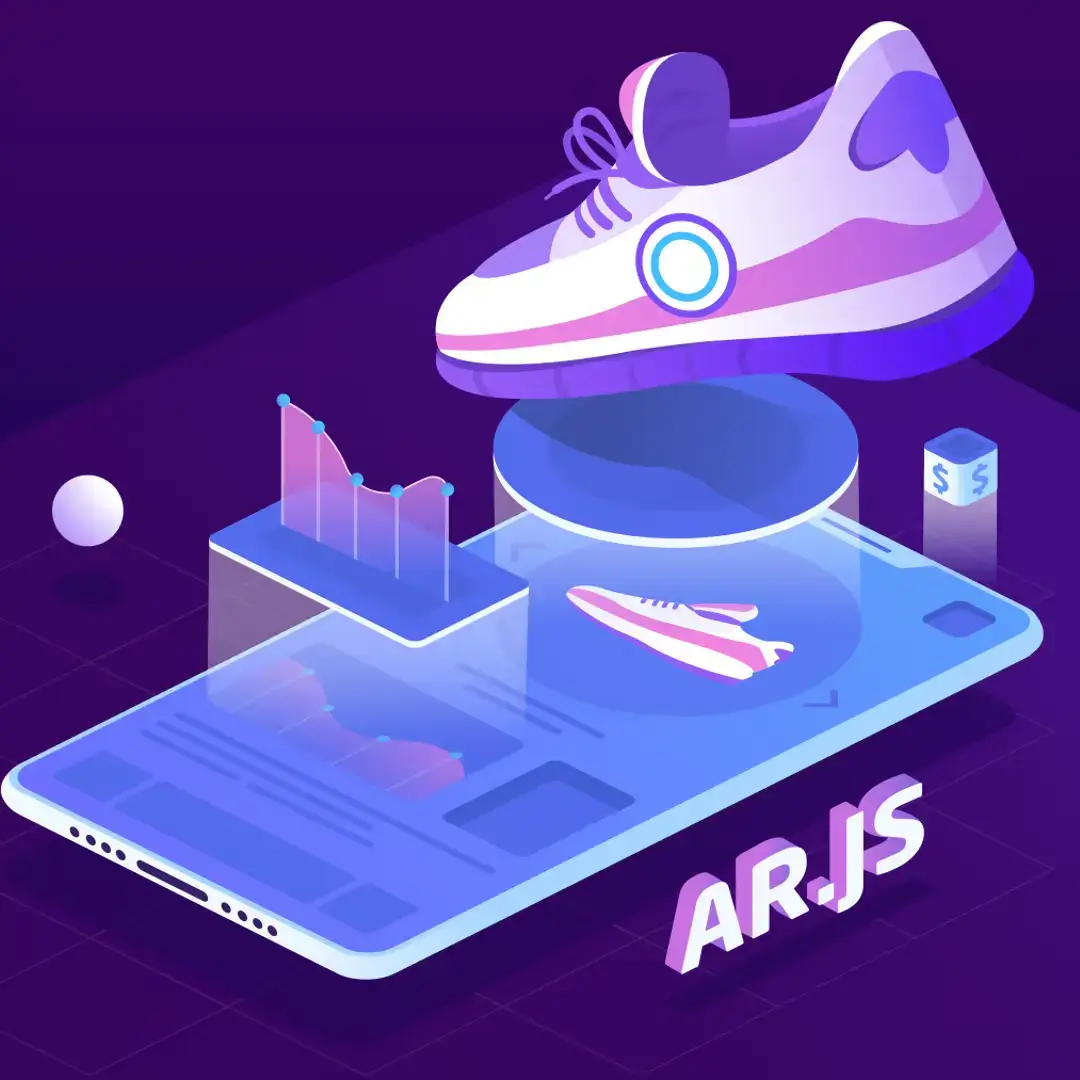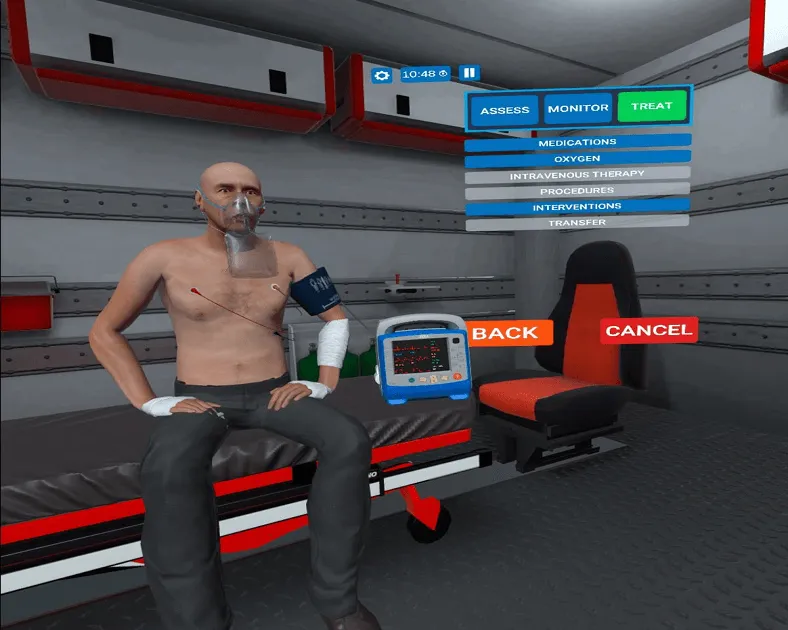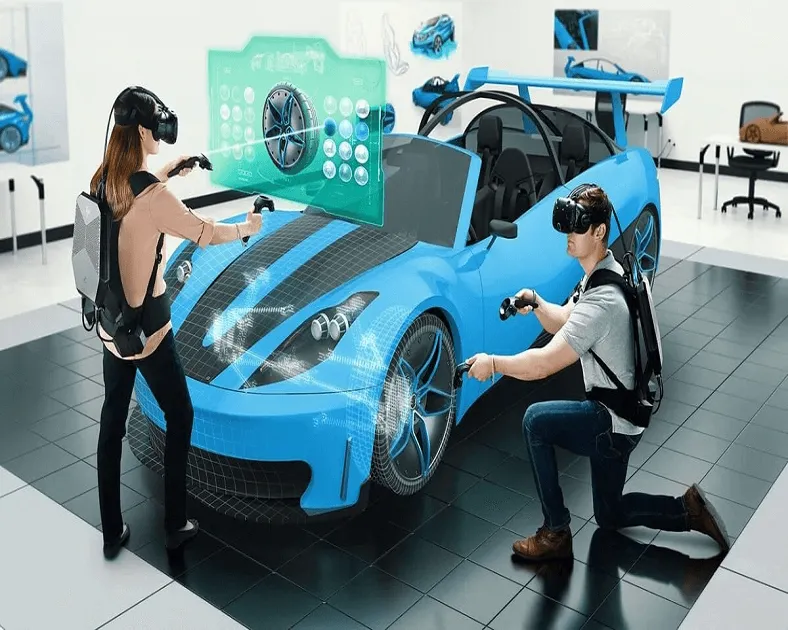AR Development Companies
What is AR or Augmented Reality?
Augmented Reality (AR) is a technology that overlays digital information, such as images, videos, or 3D models, onto the real-world environment. Unlike virtual reality (VR), which immerses users in a completely digital environment, AR enhances the real world by superimposing virtual elements onto it.
AR technology typically relies on devices such as smartphones, tablets, smart glasses, or headsets equipped with cameras, sensors, and displays to detect the user's surroundings and overlay digital content accordingly. The digital content is often contextual and interactive, meaning it can respond to the user's actions or changes in the environment.
AR has a wide range of applications across various industries, including:
-
Gaming and Entertainment: AR games allow players to interact with virtual characters and objects overlaid onto the real world. Popular examples include Pokémon GO, which overlays Pokémon characters onto the user's surroundings, and Snapchat filters, which add virtual effects to selfies and videos.
-
Education and Training: AR can enhance learning experiences by providing interactive and immersive educational content. For example, students can use AR apps to explore 3D models of historical landmarks, dissect virtual organisms, or simulate scientific experiments.
-
Retail and Marketing: AR is used in retail to create virtual try-on experiences, allowing customers to visualize how clothing, accessories, or furniture would look in their own space before making a purchase. AR can also be used in marketing campaigns to engage customers with interactive advertisements or product demonstrations.
-
Industrial and Manufacturing: AR is used in industrial settings to provide workers with real-time instructions, visual aids, and contextual information overlaid onto machinery and equipment. This can improve productivity, safety, and efficiency by reducing errors and streamlining complex tasks.
-
Healthcare: AR has applications in healthcare for medical training, surgical navigation, patient education, and rehabilitation. Surgeons can use AR to overlay virtual images onto a patient's body during surgery, providing guidance and enhancing precision.
Asfan Company stands at the forefront of the augmented reality (AR) development landscape, pushing boundaries and redefining user experiences through innovative applications of this transformative technology. With a commitment to excellence and a passion for pushing the limits of what AR can achieve, Asfan has emerged as a leading force in the industry, delivering groundbreaking solutions across various sectors.
Founding and Vision: Founded by a team of visionary technologists and creative minds, Asfan Company set out with a clear mission: to harness the power of augmented reality to revolutionize the way people interact with the world around them. From its inception, the company has been driven by a commitment to innovation, quality, and user-centric design, ensuring that its products not only meet but exceed the expectations of its clients and users.
Prominent Works: Among Asfan Company's most prominent works is its development of augmented reality applications for education, entertainment, marketing, and industrial training. Let's delve into some of the company's most notable projects:
-
Educational Augmented Reality Apps: Asfan has developed immersive AR applications aimed at enhancing learning experiences in classrooms and beyond. These apps leverage AR technology to bring subjects to life, allowing students to explore complex concepts in science, history, and other disciplines in interactive and engaging ways. By combining educational content with AR-enhanced visuals, Asfan's apps foster deeper understanding and retention among learners of all ages.
-
Entertainment Experiences: Asfan Company has collaborated with entertainment industry giants to create unforgettable AR experiences for audiences worldwide. From interactive AR games that blur the lines between the virtual and real worlds to immersive storytelling experiences that transport users to fantastical realms, Asfan's contributions to entertainment have captivated audiences and set new standards for immersive entertainment.
-
Marketing and Brand Engagement: Recognizing the potential of AR to revolutionize marketing and brand engagement, Asfan has developed cutting-edge AR solutions for businesses seeking to connect with their audiences in innovative ways. Whether through interactive AR advertisements, virtual try-on experiences for retail products, or location-based AR marketing campaigns, Asfan's solutions help brands stand out in a crowded marketplace and forge deeper connections with consumers.
-
Industrial Training and Simulation: Asfan Company has also made significant strides in the realm of industrial training and simulation, leveraging AR technology to provide immersive, hands-on training experiences for workers in various industries. By simulating real-world scenarios in a virtual environment, Asfan's AR training solutions enable trainees to develop crucial skills and competencies in a safe and controlled setting, ultimately improving workplace safety, efficiency, and productivity.
Impact and Future Directions: The impact of Asfan Company's work extends far beyond the realm of technology, touching lives and transforming industries in profound ways. Through its dedication to innovation and collaboration, Asfan continues to push the boundaries of what is possible with augmented reality, unlocking new possibilities and shaping the future of human-computer interaction.
Looking ahead, Asfan Company remains committed to its founding vision of harnessing technology to empower and inspire people, whether through educational experiences that spark curiosity and ignite a passion for learning, entertainment experiences that transport audiences to new worlds and stir the imagination, or practical applications that improve efficiency, safety, and quality of life.
Conclusion: Asfan Company stands as a beacon of innovation in the field of augmented reality development, continually pushing the boundaries of what is possible and redefining the ways in which we interact with technology and the world around us. With a diverse portfolio of groundbreaking projects and a relentless commitment to excellence, Asfan is poised to continue shaping the future of augmented reality and leaving an indelible mark on the world.
Here are some examples of our work:
Educational AR Apps: Asfan has created interactive educational AR apps designed to make learning more engaging and immersive for students. For instance, they might develop an app that allows users to explore the solar system in 3D, providing detailed information about each planet as users interact with them.
Entertainment Experiences: Asfan has collaborated with entertainment companies to develop AR-enhanced experiences for audiences. This could include creating AR games that integrate real-world environments with virtual characters and challenges, providing users with an entirely new level of interactive entertainment.
Marketing Campaigns: Asfan has helped businesses launch innovative marketing campaigns using AR technology. For example, they might create an AR app that allows customers to virtually try on clothing or accessories before making a purchase, enhancing the online shopping experience and increasing customer engagement.
Industrial Training Simulations: Asfan has developed AR applications for industrial training and simulations, allowing workers to practice complex tasks in a safe virtual environment. These applications can help improve training efficiency and effectiveness while reducing the risk of accidents or errors in real-world scenarios.
Tourism and Travel: Asfan has worked with tourism organizations to create AR experiences that enhance visitors' exploration of historical sites, landmarks, and museums. For instance, they might develop an AR app that provides virtual tours of famous landmarks, offering users additional information and interactive features as they explore.
These examples demonstrate the versatility of Asfan Company's AR capabilities and their ability to create innovative solutions tailored to the specific needs of their clients and target audiences.
Build Your Industry-specific AR Solutions

Building industry-specific AR solutions requires a deep understanding of the needs and challenges within each sector. Here are some examples of how AR can be applied across various industries:
-
Retail: Create AR shopping experiences that allow customers to visualize products in their own space before making a purchase. This can include virtual try-on for clothing and accessories, as well as visualizing furniture and home decor items in the customer's home.
-
Real Estate: Develop AR apps that enable prospective homebuyers to take virtual tours of properties and visualize potential renovations or interior designs. AR can also be used to provide additional information about properties, such as nearby amenities and historical data.
-
Education: Build interactive AR learning experiences that bring educational content to life. For example, students studying anatomy could use AR to explore 3D models of the human body, while history students could use AR to visualize historical events and locations.
-
Healthcare: Develop AR solutions for medical training, allowing students to practice procedures in a realistic virtual environment. AR can also be used to assist surgeons during procedures by overlaying patient data and medical imaging directly onto the surgical site.
-
Manufacturing: Implement AR technology to assist with assembly and maintenance tasks on the factory floor. AR can provide workers with step-by-step instructions and visual cues, reducing errors and improving efficiency.
-
Tourism: Create AR apps that enhance the tourist experience by providing interactive guides and augmented reality overlays at popular landmarks and attractions. AR can also be used to offer virtual tours of historical sites and cultural heritage sites.
-
Automotive: Develop AR solutions for automotive design and manufacturing, allowing engineers to visualize and test new vehicle designs in a virtual environment. AR can also be used to provide drivers with real-time navigation and safety information through heads-up displays.
These are just a few examples, but the possibilities for industry-specific AR solutions are virtually
limitless.
By understanding the unique needs of each sector and leveraging AR
technology creatively, companies can develop
innovative solutions that drive value and enhance the user experience.
Augmented Reality development companies solutions for any industry

-
Real Estate: AR can help reduce the barriers people face when trying to see themselves in a room. Unfinished rooms can become fully realized homes. It allows people to observe whether or not the floor plan of their dream home looks like what they want.
-
Healthcare: In the age of AR technologies, experiments with the look and construction of an automotive vehicle have become more accessible in terms of cost, resources, and time. There is no need to create expensive physical prototypes for concepts.
-
Manufacturing: Augmented reality allows engineers to access real-time information and instructions while working on complex machinery, reducing the need for manual reference materials. It also enables remote collaboration, allowing experts to provide guidance and support to technicians on the factory floor.
-
E-commerce: AR applications allow customers to try on clothes virtually, preview furniture in their homes and visualize how products look and function in real-world scenarios. AR applications also have the potential to reduce product returns as customers can get a more accurate idea of what they’re purchasing before making a purchase.
-
Education: Just as the modern business environment is continually moving toward the digital world, modern learning practices are also expanding their areas of practice. They address AR&VR services for an interactive environment with endless possibilities.
What are the benefits of using augmented reality in manufacturing?
-
Enhanced Training and Skill Development: AR can be used to create immersive training simulations that allow workers to practice operating machinery, performing assembly tasks, and troubleshooting equipment in a virtual environment. This hands-on training approach helps new hires learn faster and enables existing employees to refresh their skills more efficiently.
-
Improved Productivity and Efficiency: By providing workers with real-time instructions, visual cues, and contextual information overlaid on their physical environment, AR can streamline manufacturing processes and reduce errors. Workers can access relevant data and instructions without having to refer to manuals or computer screens, allowing them to complete tasks more quickly and accurately.
-
Reduced Downtime and Maintenance Costs: AR-enabled maintenance and repair procedures enable technicians to identify issues faster and perform repairs more effectively. By overlaying digital annotations, schematics, and diagnostic information onto equipment, AR can guide technicians through complex procedures, minimizing downtime and reducing the need for costly equipment repairs.
-
Remote Assistance and Collaboration: AR technology enables remote experts to provide real-time guidance and support to on-site workers through live video feeds and augmented annotations. This allows organizations to leverage the expertise of skilled technicians regardless of their location, improving troubleshooting capabilities and accelerating problem resolution.
-
Quality Assurance and Inspection: AR can be used to enhance quality assurance processes by overlaying digital overlays onto physical objects to highlight defects, deviations, or areas requiring attention. This enables inspectors to identify issues more quickly and accurately during the manufacturing process, reducing the likelihood of defects reaching the end customer.
-
Optimized Workflow and Resource Allocation: By analyzing data collected through AR-enabled devices, manufacturers can gain insights into workflow efficiency, resource utilization, and production bottlenecks. This information can be used to optimize processes, allocate resources more effectively, and improve overall operational performance.
Overall, the adoption of augmented reality in manufacturing offers significant potential to enhance productivity, efficiency, and quality while reducing costs and improving worker safety. As the technology continues to evolve, manufacturers are increasingly leveraging AR to drive innovation and gain a competitive edge in today's fast-paced global marketplace.
What our clients say vr company :
-
"Asfan Company's augmented reality companies solutions have truly transformed our business. The AR app they developed for us not only exceeded our expectations but also delighted our customers, enhancing their shopping experience and driving sales."
-
"Working with Asfan was a game-changer for us. Their expertise in augmented reality vr development technology enabled us to create immersive training simulations that have significantly improved our employees' skills and productivity."
-
"We were blown away by the creativity and innovation Asfan brought to the table. Their augmented reality marketing campaign not only captured our brand's essence but also resonated with our target audience, resulting in increased brand engagement and customer loyalty."
-
"Thanks to Asfan's AR solutions, our quality assurance processes have become more efficient and effective. The ability to overlay digital annotations onto physical objects has revolutionized how we inspect and identify defects, ultimately improving product quality and customer satisfaction."
-
"Asfan's augmented reality and companies applications have had a profound impact on our operations. Their remote assistance and collaboration tools have enabled us to provide real-time support to our field technicians, reducing downtime and minimizing costly equipment repairs."
These hypothetical statements reflect the potential positive impact that Asfan Company's augmented reality and virtual reality developers' services could have on their clients' businesses, highlighting aspects such as enhanced customer experiences, improved training outcomes, innovative marketing strategies, streamlined operations, and increased productivity.
Reference
Explore More Projects
-
We welcome your questions, do not hesitate to contact us
- Create virtual reality and augmented reality experiences at the best prices
- Equipping engineering laboratories with the best equipment
- Virtual tours with 360° technology and also feature that you can see them through just one link
- Create virtual reality and augmented reality experiences at the best prices
- Equipping engineering laboratories with the best equipment
-
Virtual tours with 360° technology and also feature that you can see
them through just one link



